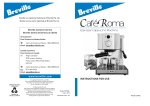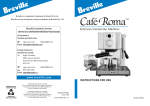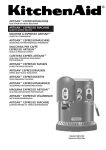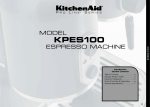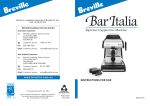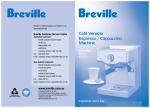Download ESP6 – Café Roma - Direct Coffee Supplies
Transcript
Café Roma www.breville.com.au Espresso / Cappuccino Machine Breville is a registered trademark of Breville Pty. Ltd. ABN 98 000 092 928 Instructions for use Breville Customer Service Centre Australian Customers ✉ Breville Customer Service Centre Locked Bag 2000 Botany NSW 2019 AUSTRALIA ☎ Customer Service: 1300 139 798 Fax (02) 9384 9601 Email Customer Service: [email protected] New Zealand Customers ✉ Breville Customer Service Centre Private Bag 94411 Greenmount Auckland, New Zealand ☎ Customer Service: 09 271 3980 Fax 0800 288 513 Email Customer Service: [email protected] © Copyright. Breville Pty. Ltd. 2004 Due to continual improvements in design or otherwise, the product you purchase may differ slightly from the one illustrated in this booklet. Model ESP6/ESP8B Issue 1/04 Model ESP6/ESP8B Contents Page 2 Breville recommends safety first 4 Know your Breville Espresso / Cappuccino Machine 5 Operating your Breville Espresso / Cappuccino Machine 6 Coffee making tips 10 Congratulations Care and cleaning 11 on the purchase of your new Breville Espresso / Cappuccino Machine. Trouble shooting chart 13 Coffees to try 14 Breville recommends safety first Know your Breville Espresso / Cappuccino Machine We at Breville are very safety conscious. We design and manufacture consumer products with the safety of you, our valued customer foremost in mind. In addition we ask that you exercise a degree of care when using any electrical appliance and adhere to the following precautions: Power On/Off switch Read all instructions before operating and save for future reference illuminates when the machine is turned on • This appliance is for household use only. • Do not use this appliance for other than its intended use. Do not use outdoors. • The appliance is not intended for use by young children or infirm persons without supervision. • Young children should be supervised to ensure that they do not play with the appliance. • Do not leave the appliance unattended when in use. • Do not touch hot surfaces. Use handles. • The installation of a residual current device (safety switch) is recommended to provide additional safety protection when using electrical appliances. It is advisable that a safety switch with a rated residual operating current not exceeding 30mA be installed in the electrical circuit supplying the appliance. See your electrician for professional advice. • Do not place this appliance on or near a hot gas or electric burner, or where it could touch a heated oven. Special safety instructions • Do not let the cord hang over the edge of a table or counter, touch hot surfaces or become knotted. • Never use the machine without water in it. • Always switch the appliance to ‘Off’, switch the power off at the power outlet and then remove the plug when the appliance is not being used and before cleaning. ‘Power On’ light (red) 15 bar Italian designed & made pump system • Any maintenance other than cleaning should be performed at an authorised Breville Service Centre. • Always use the appliance on a dry, level surface. • Do not immerse cord, plug or appliance in water or any other liquid. Cup warming plate • Only use cold water in the water tank. Do not use any other liquid. Removable 1.2 litre water tank Thermoblock heating system ‘Heating’ light (orange) illuminates to indicate that the machine is heating and will turn off when the correct temperature has been reached. This light will cycle on and off during operation to indicate the machine is monitoring the correct temperature Selector control for Espresso and Steam Filter holder External water window 2 stainless steel filters Steam wand (1 cup filter and 2 cup filter) with froth enhancer • Ensure the filter holder is firmly secured when using the machine. Steam baffle • Never remove the filter holder during the brewing operation as the machine is under pressure your electrician for professional advice. • Regularly inspect the supply cord, plug and actual appliance for any damage. If found damaged in any way, immediately cease use of the appliance and return the entire unit to your nearest authorised Breville Service Centre for examination, replacement or repair. Removable drip tray and grid 4 Combined measuring spoon and coffee press Water level indicator 5 Operating your Breville Espresso / Cappuccino Machine Before using your Espresso / Cappuccino Machine Wash the filter holder and the stainless filters in mild detergent and water. Rinse thoroughly. Filling the water tank • Ensure the power switch and selector control are set to the standby position. Pre-heating the machine Preparing the coffee For optimal crema, it is recommended to carry out a complete brewing operation with water but without any coffee grinds before making your first coffee to ensure that the machine has been preheated. • Place the 1 or 2 cup filter into the filter holder and fill with espresso coffee (use the smaller filter for 1 cup and the larger filter for 2 cups). • Make sure the selector control is in the Standby position. • Turn off at the power outlet and unplug the power cord. • Plug the power cord into a 230/240V electrical outlet, switch on and set the power switch to the ‘ON’ position. • Lift up the water tank lid and remove the water tank. Fill with cold water to the maximum mark and replace in the machine, pressing down firmly so that the water valve opens. Close the water tank lid. • As soon as the orange ‘Heating’ light turns off, set the selector control to the Espresso position and run a small amount of water through the brewing head for a few seconds without the filter holder in place. • Clean any excess coffee from the rim of the filter holder to ensure a proper fit under the brew head. • Place the filter retainer clip in the release position, by pulling the clip back towards your hand. • Use 1 level measure of espresso coffee for the 1 cup filter and 2 level measures for the 2 cup filter. It is important to use the correct amount of coffee as the filter perforations have been constructed for optimal pressure build up in the machine. • Place the filter holder underneath the brew head so that the handle is positioned to the left of centre. Lift the filter holder until it contacts the brew head and rotate to the right. Pre-warming cups For optimal coffee temperature, pre-warm the espresso cups by placing them on the cup warming plate. • Distribute the coffee evenly and press it lightly with the bottom of the measuring spoon (if there is too much coffee, the flow of water can become blocked). The water tank should be filled with fresh cold water before use. Check water level before use and replace the water daily. Do not use mineral or distilled water. Note 6 7 Operating your Breville Espresso / Cappuccino Machine continued Brewing coffee • Make sure the selector control is in the standby position. • Plug the power cord into a 230/240V electrical outlet, switch on and set the power switch to the standby position. • As soon as the orange ‘Heating’ light turns off, the machine is heated up. The machine remains ready for brewing and maintains a constant heating temperature as long as the Power switch is left in the ‘On’ position. If the temperature should drop, the orange control light will illuminate and the heater will automatically heat up to the correct brewing temperature. Note • Make sure the drip tray is in place. • Place one or two pre-heated cups beneath the filter holder. • Set the selector control to the Espresso position. • After a few seconds, aromatic coffee will begin to run through. • When sufficient coffee has flowed into the cups, set the selector control to the standby position. This will stop the flow of coffee. • If you do not need to use the steam function, set the power switch to the ‘Off’ position, unplug the power cord and allow the machine to cool. • Remove the filter holder from the brew head and using the filter retainer clip to secure the filter in the filter holder, turn the filter holder upside down to empty the used coffee (used coffee grounds should be thrown away with domestic waste and not down the sink which may block drains). Rinse the filter and filter holder with water and allow to dry. How to froth milk for a cappuccino or latte The Breville Café Roma comes complete with a frothing attachment for easier frothing of milk. The first step in making a cappuccino/latte is to make a short espresso (see “Brewing coffee”). Then: • Fill the stainless steel frothing jug 1⁄ 3 full with cold milk. • As soon as the orange ‘Heating’ light turns off, plunge the steam wand into jug of milk so that the main head of the froth enhancer is immersed into the milk. THE METAL PARTS OF THE FILTER HOLDER MIGHT STILL BE VERY HOT. COOL DOWN THESE PARTS BY RUNNING UNDER COLD WATER. MAKE SURE YOU USE THE FILTER RETAINER CLIP WHEN DISCARDING THE COFFEE GROUNDS. 8 • Set the selector control to the Steam position. • Gently move the frothing jug in a circular motion around the froth enhancer. Always ensure that the frothing attachment has been firmly pushed onto the steam wand For best results use fresh cold milk (lite milk will froth easier). • When the milk has begun to increase in volume, immerse the froth enhancer deeper into the milk to further heat the milk. Always clean the steam wand and froth enhancer after every use (refer to care and cleaning). • Place your hand on the bottom of the stainless frothing jug. When the jug becomes too hot to touch, set the selector control to the standby position to stop the steaming function before removing the jug. This will ensure that you don’t burn the milk. If brewing more coffee straight after using the steam function, set the selector control to the Espresso position to run a small amount of water through the brewing head for a few seconds without the filter holder in place. This will prepare the system for optimal brewing temperature. • When steaming milk you will hear a pumping sound. This is the thermoblock operating and is normal. Note • As you return the selector control to the standby position, steam will be released from the machine. This is normal operation. • Add the steamed milk to each cup of freshly brewed espresso coffee and spoon on the frothed milk in the following ratios: Cappuccino - 1⁄ 3 espresso, 1⁄ 3 steamed milk, 1 ⁄ 3 frothed milk Latté - 1 ⁄ 3 espresso topped with steamed milk and about 10cm of frothed milk (traditionally served in a glass) LIQUID SHOULD NOT BE ALLOWED TO RUN OVER THE TOP OF THE FROTH ENHANCER, OTHERWISE IT WILL NOT FUNCTION. TO AVOID SPLATTERING OF HOT MILK, DO NOT LIFT THE STEAM NOZZLE ABOVE THE SURFACE OF THE MILK WHILE FROTHING. ENSURE THE SELECTOR CONTROL IS IN THE STANDBY POSITION BEFORE REMOVING THE FROTHING JUG. 9 Coffee making tips Care and cleaning Tips on making the perfect espresso The grind Don’t just rely on your coffee maker to do all the work. Making a good cup of coffee is an art. • If using pre-ground coffee, ensure you purchase an espresso grind for espresso/cappuccino machines. Water flow If you’re making an espresso, make sure the water flows through the coffee filter at the correct rate. If it’s too slow, the coffee will be over-extracted - too dark and bitter, with a mottled and uneven crema on top. If it flows too quickly, the coffee will be underextracted - the proper flavour won’t have had time to develop. You can adjust the water flow by tamping (pressing down) the coffee firmly or by changing the grind of the coffee. The coffee Pre-ground coffee will only retain its flavour for 1 week, provided it is stored in an air tight container, in a cool, dark area. Whole coffee beans are recommended and should be ground just before use. Coffee beans stored in an airtight container will keep up to 1 month before they begin to lose their flavour. Do not store in a refrigerator freezer. • If grinding your own beans the coffee must be ground fine, but not too fine. It can effect the taste and the rate the water flows through it. • If the grind is too fine, the water will not flow through the coffee even under pressure (this grind looks like powder and feels like flour when rubbed between fingers). • If the grind is too coarse, the water flows through the coffee too fast, preventing a full flavoured extraction. Before cleaning, ensure the selector control is in the ‘OFF’ position. Switch off at the power outlet, then unplug the power cord and allow the unit to cool. Cleaning the steam wand and froth enhancer • The steam wand and froth enhancer should always be cleaned after frothing milk. • Remove the froth enhancer and rinse under warm tap water. • Wipe the steam wand with a damp cloth. • Briefly set the selector control to the Steam position to clear any remaining milk from the steam wand. • If the steam wand becomes blocked, wait for the machine to cool before using a needle or paperclip to unblock the opening. Cleaning the filters, filter holder and brewing head Cleaning the housing / cup warming tray • The outer housing can be cleaned with a soft, damp cloth (do not use abrasive agents or cloths which can scratch the surfaces). Cleaning the drip tray • The drip tray should be removed, emptied and cleaned at regular intervals, particularly when the water level indicator is exposed indicating the drip tray is full. • Remove the grid, steam baffle and water level indicator from the drip tray, wash all 4 parts with water and non-abrasive washing liquid before rinsing and drying. Do not place any of the components in the dishwasher. Note • Directly after use, remove used coffee grounds and rinse the stainless filters and filter holder under running water. Should the fine holes in the filters become blocked, then a normal dishwashing brush should be used (do not use a brush with metal bristles). • The brewing head should be wiped with a damp cloth to remove any old espresso grounds. • It is advisable to periodically run water through the unit with the filter in place but without any coffee to clean out any old coffee grounds. DO NOT IMMERSE ANY PART OF YOUR BREVILLE ESPRESSO/CAPPUCCINO MACHINE IN WATER OR ANY OTHER LIQUID. 10 11 Care and cleaning continued Decalcifying After regular use, hard water can cause limestone build up in and on many of the inner functioning components, reducing the brewing flow, power of the machine, and affecting the quality of coffee. We advise decalcifying the machine on a regular basis (every 2-3 months) using a liquid decalcifying agent. Follow the instructions provided, or use the following as a guide: Diluted solution (for softer water) • 1 part decalcifying agent • 2 parts cold tap water Trouble shooting chart • As soon as the brewing temperature is reached the orange ‘temperature’ light will switch off. Set the selector control to the Espresso position and let half the decalcifying solution run through the brewing head. • Turn the selector control to the Steam position and let the remaining solution run through the steam wand. When the solution has run through, set the selector control back to the ‘OFF’ position. • After decalcifying, rinse the water tank thoroughly and re-fill with fresh cold water. To rinse the machine, run half the water through the brewing head and half through the steam wand. Problem Possible causes Coffee does not run through • • • • • • Coffee runs out too quickly • Coffee grind is too coarse • Not enough coffee in the filter Coffee runs too slowly • The water tank is empty or low • Coffee grind is too fine • Machine is blocked by scale build up (see Care and cleaning) Coffee runs out around the edge of the filter holder • • • • The machine is too loud • Water tank is empty • Water tank is not securely in place Concentrated solution (for harder water) • 1 part cold tap water The machine is ready for use. The stainless steel filters should not come in contact with any decalcifying agents. Decalcifying the machine Do not use powdered decalcifying agents. • 1 part decalcifying agent • Make sure the selector control is in the standby position and that the plug is disconnected from the power outlet. • Remove the filter holder and pour in the decalcifying solution into the water tank. • Plug the machine into the power outlet and turn on. • Set power switch to the ‘On’ position and the selector control to the standby position. • Place a large container under both the water outlet and the steam wand. Note Machine is not turned on or plugged in Water tank is empty Selector control not in Espresso position Coffee grind is too fine Too much coffee in the filter The filter is blocked (see Care and cleaning) Filter holder is not inserted in the brew head properly There are coffee grounds around the filter rim Too much coffee in the filter Coffee has been tamped too tightly Coffee is too weak or watery • Coffee grind is not fine enough (use coffee ground for espresso machines) Coffee is too cold • Machine not preheated • Cups not preheated • Milk not heated enough (if making a cappuccino or latte) No crema • Coffee is not tamped (pressed) firmly enough • Coffee grind is too coarse • Coffee is not fresh No steam is generated • • • • Milk is not foamy after frothing • Not enough steam • Milk is not fresh and cold Machine is not turned on Water tank is empty Selector control not in Steam position Steam wand is blocked (see care and cleaning) THE WATER TANK SHOULD NEVER BE REMOVED OR COMPLETELY EMPTIED DURING DECALCIFYING. 12 13 Coffees to try Cappuccino A cappuccino is very light and almost luke warm. It has one-third espresso, one-third milk and one-third foam. It is traditionally consumed before noon. Espresso Intense and aromatic, an espresso or short black as it’s also known uses about 7g of ground coffee. It is served in a small cup or glass to a level of approximately 35mm. Cafe latté Served in a glass, a caffe latté consists of onethird espresso, topped with steamed milk and about 10mm of foam. Macchiato Traditionally served short, the macchiato is also poured as a long black with a dash of milk or a dollop of foam. Long black A long black is generally served with a double shot of espresso. Ristretto Meaning restricted, a ristretto is an extremely short espresso of approximately 15mm, distinguished by its intense flavour and aftertaste. 14 15










